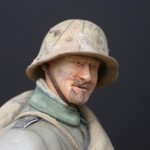
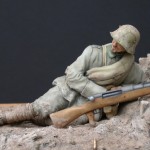
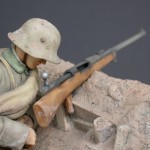
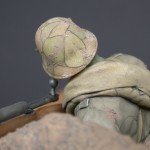
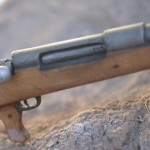
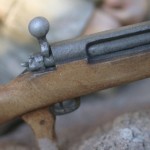
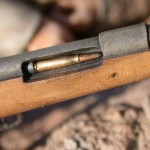
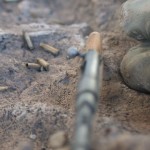
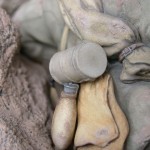
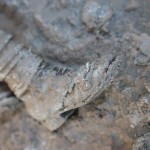
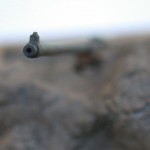

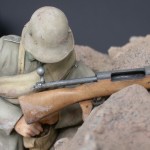
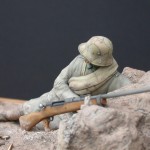
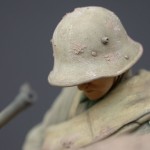
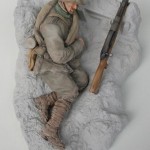
German Anti-Tank Gunner, Prussian 27th Reserve Infantry Regt. (2.Magdeburgisches) Beaucamp, Cambria, September 1918
- Scale / Maßstab: 1:16
- Approx. height of figure: 112mm
- Material: Resin (figure), Model Plaster (base) / Resin (Fugur), Modell-Gips (Sockel – synethetische, kunststoffveredelte Gießmasse)
- Parts / Teile: 30
- Infosheet / Infoblatt: English
- Code: 20TG
Contents / Inhalt:
- Figure (8 parts) / Figur (8 Teile)
- 2nd Alternative Head / 2. Alternativ-Kopf
- Water Bottle / Feldflasche M.07
- Haversack / Brotbeutel M.1887
- Gas Mask / Gasmaske M.17 Metallbehälter
- Mauser Tank Rifle (3 parts) / Tankgewehr Mauser M1918 (3 Teile)
- Standard MG 08/15 Bipod / MG08/15 Zweibein
- Ammunition Holders / Munitionstashen
- 6 x 13mm Mauser T-Gewehr Cartridges / 6 x 13mm Mauser T-Gewehr Patronen
- 6 x Empty 13mm Mauser T-Gewehr Cartridges / 6 x Leere 13mm Mauser T-Gewehr Patronen
- Stick Grenades M.15 / Stielhandgranaten M.15
- Multi Charge Grenade (4 parts) / Geballte-Ladung (4 Teile)
- Steel Helmet M.16 / Stahlhelm M.16
- Figure Base / Figur-Sockel
Extracts from the Infosheet with this figure:
The figure depicts an officer from the Prussian 27th Reserve Infantry Regt Inf.-Regt. Prince Louis Ferdinand von Preußen (2. Magdeburgisches) Nr. 27 in an action, which took place in September 1918. Part of the original combat report, with the English translation is included in this infosheet be.
27.09.18 …erste Erwähnung von Tankgewehren während der Abwehrschlachten vor Cambrai. Eine neue Gefahr entstand im Laufe des Gefechts duch das Erscheinen von Tanks, die schon in den Morgenstunden von unseren Posten im Anmarsch gemeldet waren. Anfangs hatte man die Richtigkeit dieser Meldung bezweifelt. Lt. Freytag hatte vorher Tankmunition angefordert. Er war im Besitz von 20 Tankpatronen. Plötzlich stieß aus der Flanke ein großer englischer Tank, von Beaucamp aus an der Stellung der 1. Kp entlangfahrend, gegen den alten Kampftruppenkommandeur-Unterstand vor. Infanterie und MG-Feuer vermochten ihn nicht aufzuhalten. Kurz entschlosen und mit sicherer Hand nahm Lt. Freytag persönlich mit einem Tankgewehr im letzten Augenblick den Kampf auf. Er eröffnete auf etwa 150 Meter Entfernung das Feuer. Nach dem 11. Schuß stand der Tank zum ersten Male, etwa 60 Meter vor unserer Linie. Der Tank erholte sich aber nochmals und wurde von Lt Freytag mit dem 17. Schuß auf etwa 20 Meter Entfernung zum Stehen gebracht. Die Besatzung des Tanks bestand aus sechs Mann, von denen der eine tot war. Die übrigen wurden beim Verlassen des Tanks niedergeschossen……Der Tank hatte eine starke Panzerung.
Translation:
27.09.1918 …first reports of tank-rifles during the defensive battles by Cambria. A new danger became apparent in the course of the fighting with the approach of tanks reported from our sentries during the early hours. Doubts were at first raised at these reports. Lt. Freytag had already ordered up more tank ammunition. He just had 20 rounds. Suddenly a large English tank appeared on the flank from the direction of Beaucamp, along the position of the 1st Company and heading towards the old command bunker. Infantry and MG fire were having no affect. Lt. Freytag instantly decided there and then and with a steady hand personally opened fire with the tank-rifle. He started firing at 150 meters distance. After 11 rounds and approx. 60 meters in front of our line the tank stopped for the first time. The tank resumed and was stopped with Lt Freytag’s 17th shot, approx. 20 meters distance away. The tank-crew comprised of 6 men, of which 1 was dead. The others were shot down whilst leaving the tank…the tank had strong armour.
Tent Cloth M1892 and Greatcoat / Zeltbahn M1892 und Einheitsmantel M1915: Around the upper body the soldier wears a wrapped up greatcoat inside the M1892 tent section. Under the arm the two ends are held together with the leather greatcoat-fixing strap. Colour: Light brown/grey. (On original black/white photos they always appear to be a lot lighter against the field-grey tunics of the wearers).
Mauser Tank Rifle / Tankgewehr Mauser M1918: Designed and produced in the Mauser factory at Oberndorf as a short-term answer to the new tank problem on the Western Front. This single shot bolt-action weapon was the world’s first anti-tank rifle. Total length approx. 170 cm, weight together with the 08/15 MG bipod attached 17.1 Kg. Nicknamed the Elefantenbüchse, or Elephant-rifle at the Mauser factory this weapon was too heavy, the recoil too strong and the penetration when used against armour insufficient. (Most of the allied tanks were stopped by direct or indirect artillery fire).
In action these rifles were used either with the 08/15 MG bipod (the original bipod designed for this weapon was seldom employed) or mainly without, the rifle being placed on top of the trench wall/parapet. Due to the considerable recoil and when practical the gunners would change over roles after every 2 – 3 rounds, engaging the enemy armour at as close a range as possible.
In the German Army instruction manual for the rifle it is stated that both the gunner No. 1 and 2 should be chosen for their size and strength. They should be determined, cool-headed and also good shots. The employment of the T-Gewehr in groups of 3 or individually depends on the tactical situation and lay of the ground. The use of the T-Gewehr in combination with the MG 08 or MG 08/15 using special armoured piercing SmK (SmK – Stahlmantel mit Kern) rounds increases the chances of success. At the front end of the bolt are the 3 discharge vents, which enabled excess gasses to be released during firing. Colour: the wooden stock and pistol grips were of a dark wood. All other parts were a dark gun- metal. The bolt, especially the handle were generally shinier. 13mm case – brass. Bullet head – dark copper.
Note: a common characteristic on original guns are the small indents/damages on the left hand side of the wooden butt (just behind the narrow part), caused by the rim of the gunner’s steel helmet denting the rifle on recoil – this has been reproduced on the model rifle. The separate bolt can either be built in the open or closed position. Either separate the bolt and fix accordingly, or even better, drill out the rear part of the breech (2mm hand drill) – here a small central indent has been placed for assistance. If possible and if the drill bit is long enough, drill up into the rear of the barrel a few mms as well. This will enable the bolt to function as in the original. The 13mm rounds supplied with the set will in fact fit into the breach.
Tip: in order to achieve a smoother function of the bolt moving in and out of the chamber, one can apply some sanded down pencil lead with an old paintbrush. This will not only lubricate the parts, but also give it a natural shiny appearance, just like the original.
Standard MG 08/15 Bipod / MG08/15 Zweibein: This entirely new pressed-steel lightweight bipod was to replace the large and heavy sled mounts used with the MG 08 and allowed for a 180° traverse. It had a universal attachment fitting, which could be fitted to the 08/15 MG as well the Mauser T-Gewehr – Mauser anti-tank rifle. Colour: dark green.
Ammunition Holder for Anti-Tank Rifle / Munitionstashe für T-Gewehr: In accordance with German Army Tank Rifle regulation the Gunner No.1 would carry a holder with 20 x 13mm rounds of ammunition. Gunner No. 2 or the reserve gunner is issued 2 holders (1 on each hip) and carries a wooden crate with an extra 79 rounds. These canvas holders are a rare and sought after collector’s item. The ones with the figure were modelled from pictures taken of an existing item at the Army Museum in Brussels, Belgium. The holder is made out of khaki canvas and has 2 metal buttons at the front.
Stick Grenade / Stielhandgranate M.15: The second type of German stick grenade to be issued (in greater numbers from 1916 onwards). The turned wooden handle would have the fuse duration stamped on one side, along with the makers name and production date. This grenade had the advantage of a screw cap, covering the porcelain ball and pulls cord igniter-system inside, keeping it dry and free from dirt. Most stick grenades were set with a 5.5 or 7-second time delay. The cap crown has 8 knurled indents to enable a better grip in wet/muddy conditions, or when wearing cloves. The metal clip on the side of the explosive charge is for attaching to equipment etc. On some original photos it can be seen that the screw caps have already been removed, ready for instant use if needed. The original master model was made using a fine grain wood to reproduce the surface of the handle. Colour: Metal parts – green/grey. Wooden stick/handle – untreated wood starts turning grey after a length of time when exposed to the elements.
Note: with a bit of care and a thin, sharp blade it is possible to hollow out the gap behind the clip and the explosive charge, not forgetting to leave the bottom part of the clip still attached.
Multi Charge Grenade / Geballte-Ladung: Made out of 7 stick grenades and generally used against enemy dugouts and strongpoints. These multi charges were made by the troops themselves at the front. Original photos show the middle grenade surrounded with 6 grenade heads without the handles, secured by several loops of wire, tied under the metal belt clips. The shape of the grenade heads means that they do not sit snug together on account of the protruding bottom rim. Due to moulding techniques the areas in between the grenade heads are filled out. Colour: Metal parts – green/grey. Wooden stick/handle – untreated wood starts turning grey after a length of time exposed to the elements.
Ball Grenade M 1913 / Kugelhandgranate M 1913 a. A. (alte Art – old type): This grenade was made out of cast-iron with large external segments. The friction delay fuse was activated by pulling the twisted priming wire – for this there was an extra wrist lanyard with a snap hook. Later types of Kugelhandgranaten had a more simplified outer casing and were sometimes issued painted green. Colour: Grenade – mainly black. Fuse – brass. A twisted priming wire can be constructed using a thin wire or similar and inserted into a small hole drilled at the top of the fuse.
The Base: The base supplied with the figure depicts a section of old trench, damaged by previous artillery fire. Parts of the wooden revetment can still be made out around the raised area. On the base next to the figure’s left knee is a small indent for the bottom corner of the Mauser rifle butt to be positioned – this is of cause optional.
The area of Cambria, France has a brown soil, with small stones.
 An deutschsprachige Interessenten:
Sie können mich per eMail oder Telefon auch gerne auf deutsch kontaktieren. Ortsbesuch ist nach Absprache möglich.
An deutschsprachige Interessenten:
Sie können mich per eMail oder Telefon auch gerne auf deutsch kontaktieren. Ortsbesuch ist nach Absprache möglich.
